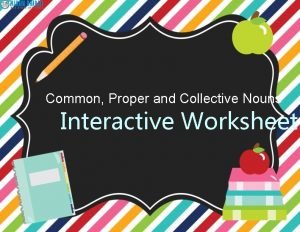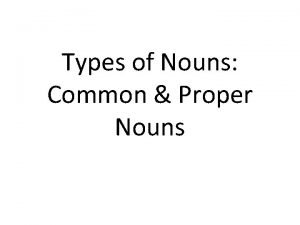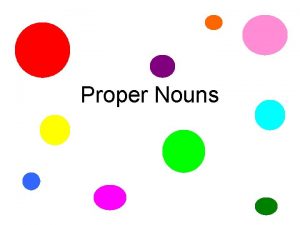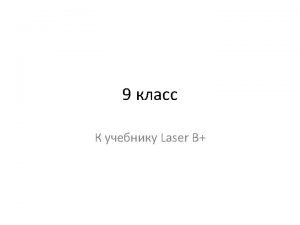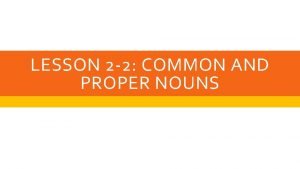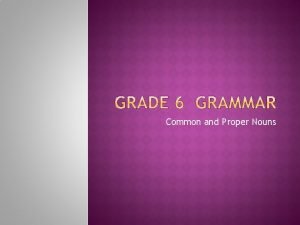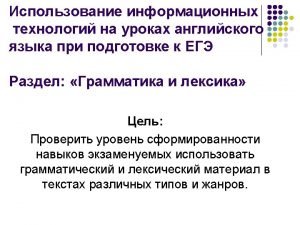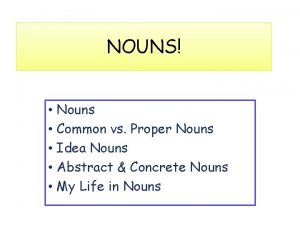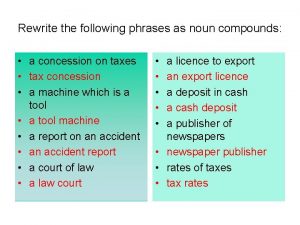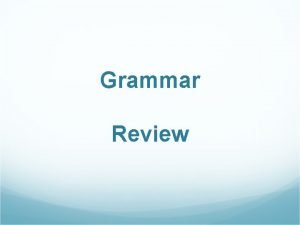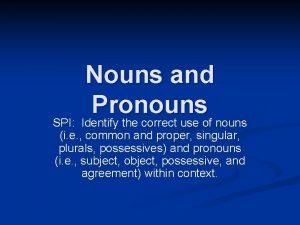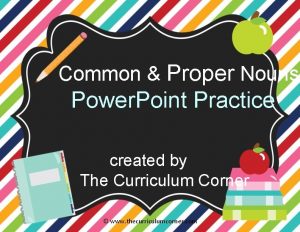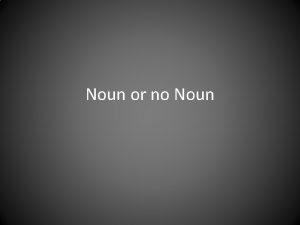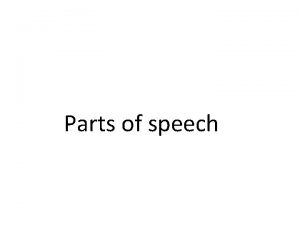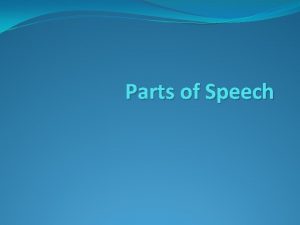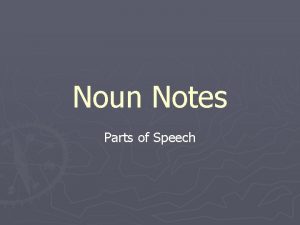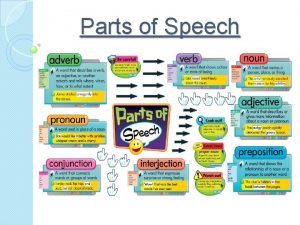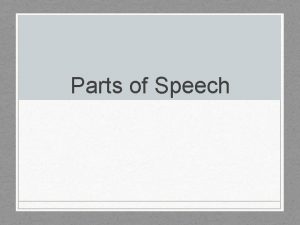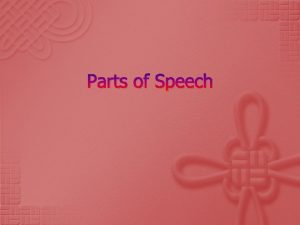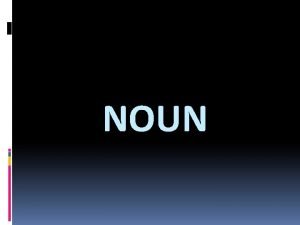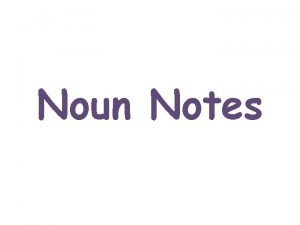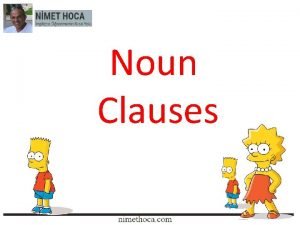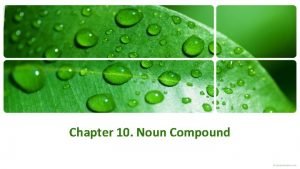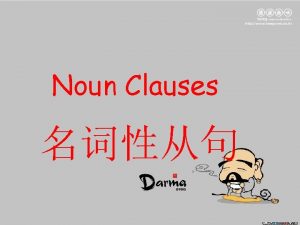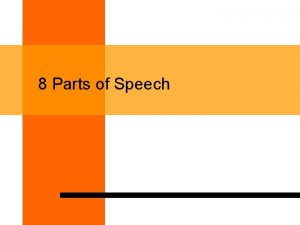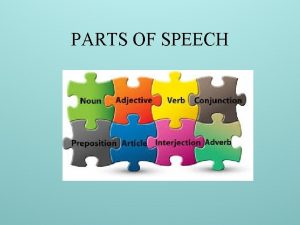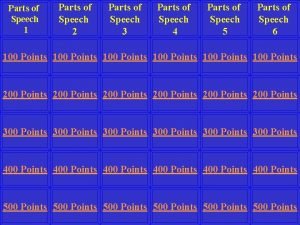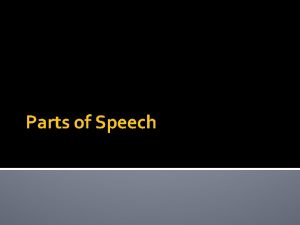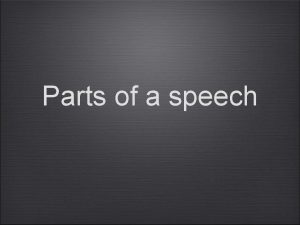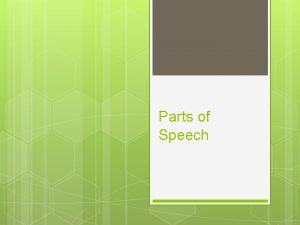The Parts of Speech Parts of Speech Noun
























- Slides: 24

The Parts of Speech

Parts of Speech • • Noun Pronoun Verb Adjective Adverb Conjunction Preposition Interjection

Noun • Is a word which names a person place or thing (this includes ideas) • Two types of nouns: – Common nouns – Proper nouns

Pronoun • Is a word which takes the place on a NOUN • A pronoun must have a specific, stated antecedent • A pronoun must agree with its antecedent in person, number, and gender.

Verb • A verb is a word which shows action • Or, existence, the state of being • A verb MUST agree with its subject in person and number

To BE The Infinitive/Parent Form • • Be Is Am Are • • Was Were Being Been

Adjective • • • Is a word that describes a noun or pronoun Compare Tell how many What kind Describe attributes (color, height, size, etc. ) • Proper adjectives- a noun form that functions like an adjective



Articles • • They are pronouns The A An (used with words that start with a vowel sound)

Adverb • A word which describes, or modifies: – a verb, – an adjective, – or another adverb







Conjunctions are words which connect words, phrases, and clauses • Coordinating Conjunctions • Correlative Conjunctions • Subordinating Conjunctions

Coordinating Conjunctions • Must connect equals (equal phrases, clauses, sentences, and parts of speech) • Common coordinating conjunctions: – But, and, for, yet, nor, so

Correlative Conjunctions • Conjunctions that are use in pairs – Either/or – Neither/nor – Not only/but also – Both/and – Whether/or – As/so

Subordinating Conjunctions • Connect phrases and clauses that are NOT equal. • Common subordinate conjunctions: – After -Because – Whenever -Before – Even though-When – Until -Although – Though -As if

Preposition • Is a word which shows location in time and place • Shows the relation between it’s object (noun/pronoun) and another word in the sentence • A prepositional phrase acts like an adjective or adverb

Interjection • Are words which demonstrate strong emotions or feelings • Usually offset by a comma or exclamation point.

 Proper noun common noun collective noun worksheet
Proper noun common noun collective noun worksheet Proper nouns vs common nouns
Proper nouns vs common nouns Common noun girl
Common noun girl Caroline have a walkman
Caroline have a walkman Proper noun images
Proper noun images Paragraph using common and proper nouns
Paragraph using common and proper nouns Complete the table which adjectives are negative
Complete the table which adjectives are negative Countable and uncountable nouns project
Countable and uncountable nouns project Proper noun idea
Proper noun idea Noun phrase
Noun phrase Compound nouns
Compound nouns Nouns person place or thing
Nouns person place or thing Brainpop jr nouns
Brainpop jr nouns Noun clause sentence
Noun clause sentence Takes the place of a noun or noun phrase
Takes the place of a noun or noun phrase Common and proper nouns powerpoint
Common and proper nouns powerpoint Hình ảnh bộ gõ cơ thể búng tay
Hình ảnh bộ gõ cơ thể búng tay Frameset trong html5
Frameset trong html5 Bổ thể
Bổ thể Tỉ lệ cơ thể trẻ em
Tỉ lệ cơ thể trẻ em Gấu đi như thế nào
Gấu đi như thế nào Chụp tư thế worms-breton
Chụp tư thế worms-breton Chúa yêu trần thế alleluia
Chúa yêu trần thế alleluia Môn thể thao bắt đầu bằng chữ f
Môn thể thao bắt đầu bằng chữ f Thế nào là hệ số cao nhất
Thế nào là hệ số cao nhất
